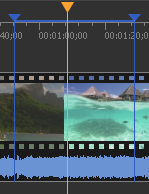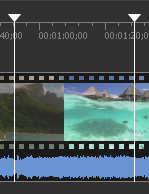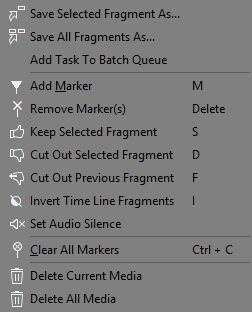Basic usage
In this section:
Opening a source file
Operations with files are performed via the menu bar in HyperCam Media Editor.
To open a source file, go to the menu bar, select File -> Open Media File... Select your video file in standard Open File dialog box. This file will not be changed, deleted or moved during the splitting process.
To set the destination file, select File -> Output File... and specify the name for the destination file. If a file with the same name already exists, you will be asked if you want to replace the old file with the new one. You can overwrite the old file or specify a new filename for the destination file.
If the file you edit contains several audio and/or video streams then after the file opening you will see Stream selection window, where you can select video and audio tracks for preview and editing.
See also: File menu, Stream selection window.
Using the splitting controls
Before you start the trimming process, you should define the intervalss you want to be cut or kept in the output file.
To add a new interval to the slider:
- Navigate to the beginning of the future interval
- Press the Set New Marker key (M) or select the Edit -> Set New Marker menu item from the menu bar
- Navigate to the end of the future interval
- Repeat step 2
- If necessary, mark the interval as "Cut Off" by selecting Edit -> Cut Off Selected Fragment (D) or pushing the "Scissors" (
 ) button
) button - If you need to change the start or stop interval positions, just double click on the collapsed marker and drag the markers to their new positions

Sample intervals:
| Interval color | Description |
 |
This interval is set to be kept. It will be present in the final movie. The blue color of markers means you can edit it (delete, set it to be kept, etc.) |
 |
Cut out interval. The blue color shows it is selected. |
 |
This interval is set to be kept. It will be present in the final movie. The white color of markers means that this interval can not be edited. |
 |
Cut out interval, not selected. |
Splitting controls
| Window Item | Description | Shortcut key |
 |
Add Marker: Add a new marker to the current slider cursor position. | M |
 |
Delete Marker: Remove selected marker or markers. | Delete |
 |
Set audio silence: allows to set audio silence for the selected interval | |
 |
Start trimming or batch processing (if there are any tasks in the batch queue) | Ctrl + T |
 |
Browse output file | |
 |
Left marker cursor time position. You can edit this value manually | |
 |
Right marker cursor time position. You can edit this value manually | |
 |
Zoom: Increase or Decrease the slider timeline resolution to make editing neighbouring markers more comfortable (*) |
NumPad + NumPad - |
 |
Displays zoom popup menu | |
 |
Invert intervals selection | |
 |
Get screenshot: allows to make the screenshot of the chosen video frame Browse screenshot: allows to open folder with the created screenshot |
|
 |
Mute selected audio track. Muted track will not be present in either the preview or the output file. | |
 |
Minimize selected track on the timeline. |
Slider context menu

| Menu item | Description | Shortcut key |
| Save Selected Fragment As... | Specify the output filename and immediately save the selected interval (start the trimming process) | |
| Save All Fragments As... | Specify the output filename and immediately save all intervals (start the trimming process) | |
| Add Task To Batch Queue | Allows to add Task to Batch Queue | |
| Add New Marker | Add a new marker to the current slider cursor position | M |
| Remove Marker(s) | Remove the current marker or interval | Delete |
| Keep Selected Fragment | Sets the type of the selected interval to be kept | S |
| Cut Out Selected Fragment | Set the type of the selected interval to be cut | D |
| Cut Out Previous Fragment | Set the type of the previous interval to be cut | F |
| Invert Time Line Fragments | Invert time line fragments | I |
| Set audio silence | Allows to mute sound of the selected interval | |
| Clear All Markers | Remove all markers | Ctrl + C |
| Delete Current Video | Allows deleting the current video file from the multitimeline |
Starting the trimming process
To start the trimming process after you set all the intervals you want to be deleted/saved, click the Save button (for details, see Splitting controls) or select File -> Save Media File As... (for details, see File menu)
Note: You can save (trim) any selected interval using the Save Selected Fragment As.. item from the slider context menu (for details, see Splitting controls)
Voice-over
In this section you will find out how to make a voice-over for your video.
Load your file and select intervals you want to keep or cut out as
described in the Using the splitting controls section.
Start recording the voice-over pushing a "Microphone" button ( ) from the Media or pushing the R hotkey. After a 3-second delay the recording will start.
) from the Media or pushing the R hotkey. After a 3-second delay the recording will start.
During a delay the countdown is displayed.

Recording will start after the countdown. The beginning will be set to the position pointed by the slider. When you're done with recording, push the "Stop Recording" button ( ) or push R hotkey again.
) or push R hotkey again.

You can do several recordings at necessary time positions or move existing recordings.
Also you can modify the length of your recording by moving its edges.
Now you are ready to save your changes to the output file: push the Save button to save output file.
Copyright © Solveig Multimedia, 2005-2022
